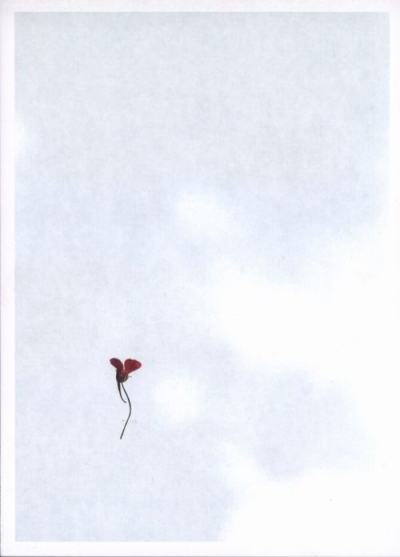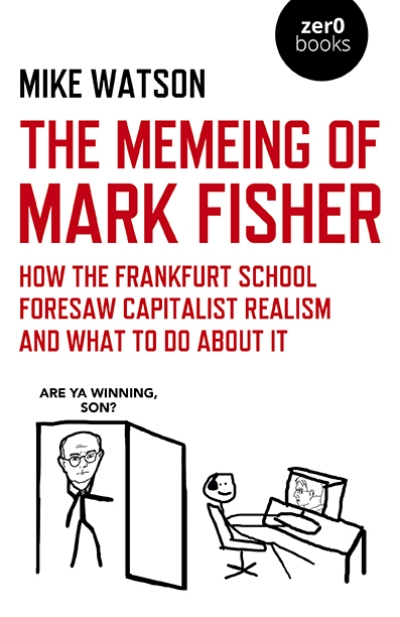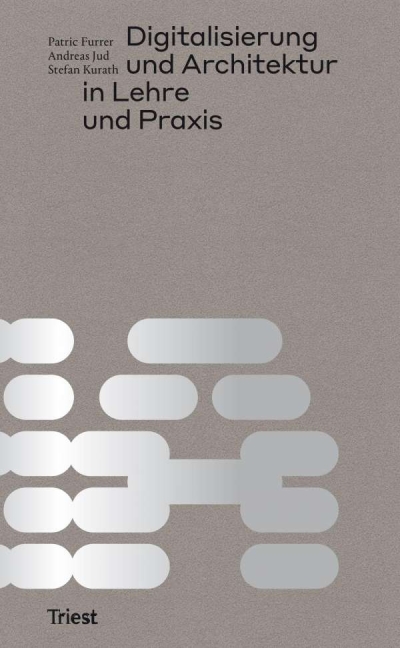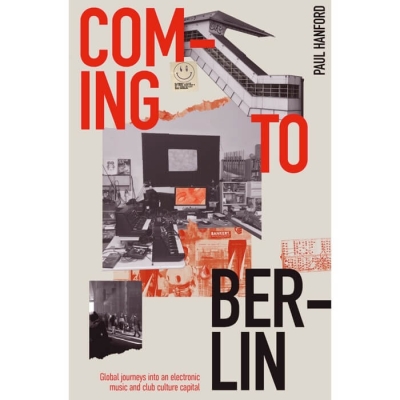Keita Noguchi
Flower
gerade nicht auf Lager
Mike Watson
The Memeing of Mark Fisher
gerade nicht auf Lager
Patric Furrer, Andreas Jud, Stefan…
Digitalisierung und Architektur in Lehre und Praxis
Paul Hanford
Coming to Berlin
gerade nicht auf Lager
Boris Buden
Transition to Nowhere. Art in History After 1989
Tirdad Zolghadr (Hg)
REALTY. Beyond the Traditional Blueprints of Art &…
gerade nicht auf Lager
Albena Yaneva
Latour for Architects
gerade nicht auf Lager
Raffaele Pernice (Hg)
The Urbanism of Metabolism. Visions, Scenarios and Models…
gerade nicht auf Lager
Jule Govrin
Politische Körper. Von Sorge und Solidarität
Alice Rawsthorn, Paola Antonelli
Design Emergency: Building a Better Future
Carlotta Zucchini (Ed.)
Rizoma Architetture. Togetherness
Robert Stürzl
Hans-Walter Müller und das lebendige Haus
Kenny Cupers, Sophie Oldfield, Manuel…
What Is Critical Urbanism? Urban Research as Pedagogy
gerade nicht auf Lager
Geert Lovink
Stuck on the Platform. Reclaiming the Internet
gerade nicht auf Lager
Friedrich von Borries, Jens-Uwe Fischer
Gefangen in der Titotalitätsmaschine. Der Bauhäusler Franz…
gerade nicht auf Lager
Stefan Maneval, Jennifer A. Reimer (eds…
Forms of Migration. Global Perspectives on Im/migrant Art…
gerade nicht auf Lager
Winfried Nerdinger, Wilhelm Vossenkuhl…
Otl Aicher. Designer. Typograf. Denker.
gerade nicht auf Lager
Ana Vujanovic, Bojana Cvejic
Toward a Transindividual Self. A study in social dramaturgy
gerade nicht auf Lager
Domenico Quaranta and Janez Janša (eds.)
Hyperemployment – Post-work, Online Labour and Automation
gerade nicht auf Lager
Bani Brusadin
The Fog of Systems. Art as Reorientation and Resistance in…
gerade nicht auf Lager
Pau Waelder
You can be a wealthy art collector in the digital age //…
gerade nicht auf Lager
Andrew Witt
Formulations. Architecture, Mathematics, Culture (Writing…
gerade nicht auf Lager
Nick Axel, Nikolaus Hirsch, Daniel…
Accumulation. The Art, Architecture, and Media of Climate…
gerade nicht auf Lager
Andreas Kemper
Privatstädte. Labore für einen neuen Manchesterkapitalismus
Vogliamo tutto (Hg.)
Revolutionäre Stadtteilarbeit. Zwischenbilanz einer…
gerade nicht auf Lager
Jan Herres
Das Berliner Zimmer. Geschichte, Typologie,…
gerade nicht auf Lager
Jonathan Crary
Scorched Earth. Beyond the Digital Age to a Post-Capitalist…
gerade nicht auf Lager
Cary Wolfe
Art and Posthumanism. Essays, Encounters, Conversations
gerade nicht auf Lager
Joanna Zylinska (Hg)
The Future of Media
gerade nicht auf Lager
Matthew Gandy
Natura Urbana. Ecological Constellations in Urban Space
gerade nicht auf Lager
Matthew Wizinsky
Design after Capitalism. Transforming Design Today for an…
Katja Eydel
Appointed Habitus Set
gerade nicht auf Lager
Yaiza Camps, Moritz Grünke, Pascale…
Decolonizing Art Book Fairs: Publishing Practices from the…
gerade nicht auf Lager
Carla Zaccagnini
Carla Zaccagnini. Cuentos de Cuentas
Beate Söntgen, Julia Voss (Hg.)
Why Art Criticism? A Reader.
gerade nicht auf Lager
Denise Ferreira da Silva
Unpayable Debt
gerade nicht auf Lager
Carol Vernallis, Holly Rogers, Jonathan…
Cybermedia. Explorations in Science, Sound, and Vision
gerade nicht auf Lager
Kathy Acker, McKenzie Wark
Du hast es mir sehr angetan. E-Mails 1995/96
gerade nicht auf Lager
Kirsty Bell
The Undercurrents. A Story of Berlin
gerade nicht auf Lager
Arnold Bartetzky Nicolas, Karpf, Greta…
Architektur und Städtebau in der DDR. Stimmen und…
Barbara Winckler, Enass Khansa,…
Thinking Through Ruins. Genealogies, Functions, and…
Reclaim Your City
Bitte Lebn. Urbane Kunst & Subkultur in Berlin 2003 -…
gerade nicht auf Lager
Claudia Mareis, Moritz Greiner-Petter,…
Critical by Design? Genealogies, Practices, Positions
Arch+ Zeitschrift für Architektur und…
Arch+ 247. Cohabitation
dérive
dérive N° 87, Sampler (Apr-Jun 2022)
Anna-Sophie Springer & Etienne…
These Birds Of Temptation (Intercalations 6)
gerade nicht auf Lager
Ioanna Gerakidi & Danae Io
In the Current of the Situation
gerade nicht auf Lager
Ricardo Devesa
Outdoor Domesticity. On the Relationships between Trees,…
Nils Wortmann
Alles so schön still hier 100 Ambient-Alben, die man gehört…
Herbert Haffner
His Master's Voice. Die Geschichte der Schallplatte.…
Markus Müller (Hg)
Free Music Production. FMP - The Living Music
gerade nicht auf Lager
Alexander Opper, Katharina Fink, Nadine…
Das Bauhaus verfehlen/ Missing the Bauhaus
gerade nicht auf Lager
Katharina Fink, Marie-Anne Kohl, Nadine…
Ghosts, spectres, revenants. Hauntology as a means to think…
Christine Schranz (ed.)
Shifts in Mapping. Maps as a tool of knowledge
Finn Dammann, Boris Michel (Hg.)
Handbuch Kritisches Kartieren
Krypto-Kunst Kolja Reichert
Krypto-Kunst. NFTs und digitales Eigentum (Digitale…
Phil Bernstein
Machine Learning. Architecture in the Age of Artifical…
gerade nicht auf Lager
Alexander Stumm, Victor Lortie (Hg)
Überbau. Produktionsverhältnisse der Architektur im…
Giovanna Borasi (Hg.)
A Section of Now. Social Norms and Rituals as Sites for…
gerade nicht auf Lager
Boris Groys
Philosophy of Care
gerade nicht auf Lager
Terry Smith
Curating the Complex and the Open Strike
gerade nicht auf Lager
Pedro Neves Marques (ed.)
YWY, Searching for a Character between Future Worlds Gender…
gerade nicht auf Lager
Bassam El Baroni (ed.)
Between the Material and the Possible. Infrastructural Re-…
gerade nicht auf Lager
AA Cavia
Logiciel. Six Seminars on Computational Reason
IDEA Magazine
IDEA 397. Encountering Books. Art Book Fairs of the World,…
gerade nicht auf Lager
Oxana Timofeeva
Solar Politics (Theory Redux)
gerade nicht auf Lager
Dhanveer Singh Brar
Teklife, Ghettoville, Eski. The Sonic Ecologies of Black…
gerade nicht auf Lager
Jeanne van Heeswijk, Maria Hlavajova,…
Toward the Not-Yet. Art as Public Practice
gerade nicht auf Lager
Karin Harrasser
Surazo
gerade nicht auf Lager
Oli Freke
Synthesizer Evolution: From Analogue to Digital and Back
gerade nicht auf Lager
Felix Pfeiffer-Kloss (Hg)
Berlin U-Bahn Architecture & Design Map. Berliner U-…
gerade nicht auf Lager
Alvin Lucier
Eight Lectures on Experimental Music
gerade nicht auf Lager
Derek Lamberton (Hg.)
Brutalismus Stadtplan Berlin. Brutalist Berlin Map
gerade nicht auf Lager
Laurie Penny
Sexuelle Revolution. Rechter Backlash und feministische…
bell hooks
Männer, Männlichkeit und Liebe
Angela Million, Christian Haid, Ignacio…
Spatial Transformations. Kaleidoscopic Perspectives on the…
gerade nicht auf Lager
Simone Forti
Simone Forti. Handbook in Motion. An Account of an Ongoing…
gerade nicht auf Lager
Paul Dobraszcyk
Architecture and Anarchism. Building without Authority
Elke Genzel, Pamela Voigt
BUCH ZWEI. Leben in Kunststoffbauten
Marie-Luise Angerer
Nichtbewusst. Affektive Kurzschlüsse zwischen Psyche und…
Martin Eberle
Hi Schatz!
Ernesto Laclau
Die populistische Vernunft
gerade nicht auf Lager
Desiree Förster
Aesthetic Experience of Metabolic Processes
Brandon LaBelle
Dreamtime X
Israel Martínez
Dead People Whispering to Us
Rodrigo Karmy Bolton
The Future Is Inherited: Fragments of a Chile in Revolt
Ina Wudtke
Worker Writers / Arbeiterschriftsteller:innen
gerade nicht auf Lager
Ekaterina Degot, David Riff, Jan Sowa (…
Perverse decolonisation? (Deutsche Ausg.)
gerade nicht auf Lager
The Otolith Group, Megs Morley (Hg)
Xenogenesis. The Otolith Group (Anjalika Sagar, Kodwo Eshun)
gerade nicht auf Lager
Karin Krauthausen, Rebekka Ladewig (Hg.)
Modell Hütte. Von emergenten Strukturen, schützender Haut…
Edited by Michèle Leloup, Cyrille…
The Wood That Makes Our City
Lars Henrik Gass (Hg.)
Hellmuth Costard. Das Wirkliche war zum Modell geworden
Peter Swinnen, Nikolaus Hirsch
A.J. Lode Janssens 1,47 mbar
Juliane Rebentisch
Der Streit um Pluralität. Auseinandersetzungen mit Hannah…
Helke Sander
I like chaos, but I don’t know, whether chaos likes me
gerade nicht auf Lager
Viction Workshop (Hg.)
More Is More: Designing Bigger, Bolder, Brighter
Cristina Baldacci, Clio Nicastro,…
Over and Over and Over Again Reenactment Strategies in…
Pauline Agustoni, Satomi Minoshima
Craft Portrait: Dorozome


































































































